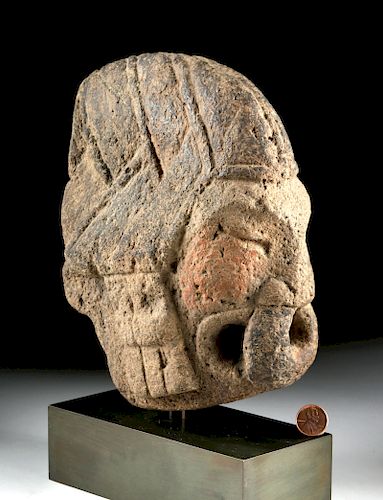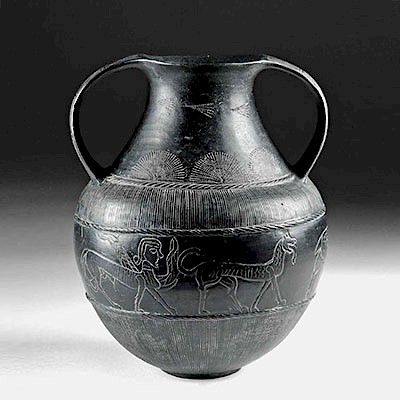Superb Veracruz Stone Hacha - Original Pigments
Lot 145f
About Seller
Artemis Gallery
686 S Taylor Ave, Ste 106
Louisville, CO 80027
United States
Selling antiquities, ancient and ethnographic art online since 1993, Artemis Gallery specializes in Classical Antiquities (Egyptian, Greek, Roman, Near Eastern), Asian, Pre-Columbian, African / Tribal / Oceanographic art. Our extensive inventory includes pottery, stone, metal, wood, glass and textil...Read more
Estimate:
$2,500 - $3,500
Absentee vs Live bid
Two ways to bid:
- Leave a max absentee bid and the platform will bid on your behalf up to your maximum bid during the live auction.
- Bid live during the auction and your bids will be submitted real-time to the auctioneer.
Bid Increments
| Price | Bid Increment |
|---|---|
| $0 | $25 |
| $300 | $50 |
| $1,000 | $100 |
| $2,000 | $250 |
| $5,000 | $500 |
| $10,000 | $1,000 |
| $20,000 | $2,500 |
| $50,000 | $5,000 |
| $100,000 | $10,000 |
| $200,000 | $20,000 |
About Auction
By Artemis Gallery
Mar 21, 2019
Set Reminder
2019-03-21 10:00:00
2019-03-21 10:00:00
America/New_York
Bidsquare
Bidsquare : Fine Ancient | Asian | Ethnographic Art
https://www.bidsquare.com/auctions/artemis-gallery/fine-ancient-asian-ethnographic-art-3967
Featuring classical antiquities, ancient and ethnographic art from cultures encompassing the globe, plus fine art. Egyptian, Greek, Roman, Etruscan, Near Eastern, Asian, Pre-Columbian, Native American, African / Tribal, Oceanic, Spanish Colonial, Russian, Fine Art, so much more! Artemis Gallery info@artemisgallery.com
Featuring classical antiquities, ancient and ethnographic art from cultures encompassing the globe, plus fine art. Egyptian, Greek, Roman, Etruscan, Near Eastern, Asian, Pre-Columbian, Native American, African / Tribal, Oceanic, Spanish Colonial, Russian, Fine Art, so much more! Artemis Gallery info@artemisgallery.com
- Lot Description
Pre-Columbian, Veracruz, ca. 550 to 800 CE. An expertly carved and well-preserved hacha, hewn from a large piece of volcanic rock to serve as one of the ritual items associated with the Mesoamerican ballgame. Hachas sometimes represented human heads, like this one depicting a sacrificial victim related to the ballgame wearing ornate head gear, the overall form flattened to resemble a symbolic axe - hence the name "hacha," meaning "axe" in Spanish. Here, the visage is depicted in profile (on both sides) with closed eyes, a broad browline leading to a naturalistic nose adorned by an enormous nose ring that falls over his open mouth - topped by an intricately delineated helmet with multiple sections with large ear flaps - and still adorned by generous traces of red and black pigments. Size: 9" H (22.9 cm); 10.875" H (27.6 cm) on included custom stand.
Hachas were associated with the ritual Mesoamerican ball game, though they were not actually part of the player's equipment. Instead these were worn during ritualistic ceremonies related to the game. The name stems from the fact that they were believed to be axe-heads; hence the term hacha (Spanish for axe). Based on ceramic figures and imagery on stone carvings, some authors have proposed that hachas were meant to be attached to yugos (yokes). Others suggest that some of the hachas could have served as ball court markers.
Provenance: private Huntington Valley, Pennsylvania, USA collection; ex-private West Coast, USA collection
All items legal to buy/sell under U.S. Statute covering cultural patrimony Code 2600, CHAPTER 14, and are guaranteed to be as described or your money back.
A Certificate of Authenticity will accompany all winning bids.
We ship worldwide and handle all shipping in-house for your convenience.
#144548Normal surface wear with scratches and abrasions as shown. Smaller perforations to the stone are inherent to it. Liberal traces of red and black pigments over the surface. Scattered mineral deposits.Condition
- Shipping Info
-
All shipping is handled in-house for your convenience. Your invoice from Artemis Gallery will include shipping calculation instructions. If in doubt, please inquire BEFORE bidding for estimated shipping costs for individual items.
-
- Buyer's Premium



 EUR
EUR CAD
CAD AUD
AUD GBP
GBP MXN
MXN HKD
HKD CNY
CNY MYR
MYR SEK
SEK SGD
SGD CHF
CHF THB
THB














